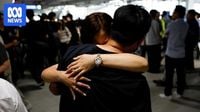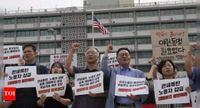On a humid September morning in Seoul, hundreds of protesters gathered outside the U.S. Embassy, their voices rising in anger over a diplomatic crisis that few could have predicted just weeks earlier. Waving signs and chanting slogans, the demonstrators demanded answers for the detention of more than 300 South Korean workers in Georgia, a move that has sent shockwaves through the corridors of power in both Washington and Seoul. The incident, which unfolded after a high-profile immigration raid at a Hyundai battery plant in Ellabell, Georgia, has exposed a simmering conflict at the heart of President Donald Trump’s economic agenda: the tension between his hardline immigration crackdown and his drive to attract foreign investment.
The story begins in early September 2025, when U.S. Immigration and Customs Enforcement (ICE) agents descended on the $4.3 billion Hyundai battery plant, a sprawling facility co-owned with LG Energy Solution and touted as Georgia’s largest economic development project. According to the Associated Press, the raid was the largest single-site immigration enforcement in recent memory, resulting in the arrest of 475 workers—most of them South Korean nationals who had arrived on short-term visas or through the visa waiver program to oversee the plant’s construction. In a scene that quickly went viral in South Korea and beyond, ICE released video footage of the detained workers being led away in handcuffs and ankle shackles, prompting outrage and swift condemnation from Seoul.
The fallout was immediate. Within days, President Lee Jae Myung of South Korea warned that the episode could jeopardize future investment in the United States. “If the U.S. can’t promptly issue visas to the technicians and other skilled workers needed to launch plants, then establishing a local factory in the United States will either come with severe disadvantages or become very difficult for our companies,” Lee said on September 11, 2025, as reported by the Associated Press. “They will wonder whether they should even do it.”
That warning carried real weight. South Korea, already a top foreign investor in the U.S., had pledged just two months earlier to pour $350 billion into American projects as part of a sweeping trade deal. In 2024 alone, South Korea ranked 12th globally with $93 billion in total U.S. investment, including major acquisitions and factory construction, according to the U.S. Bureau of Economic Analysis. The Georgia battery plant itself was a flagship of this new era of cooperation, promising to deliver 40,000 direct and indirect jobs and supply batteries for electric vehicles—a cornerstone of the Biden and Trump administrations’ push for domestic manufacturing and green energy.
But the ICE raid threw those ambitions into disarray. Hyundai CEO José Muñoz, speaking to reporters on September 12, 2025, revealed that the plant’s opening would be delayed by two to three months, a setback he squarely blamed on the sudden loss of specialized foreign workers. “For the construction phase of the plants, you need to get specialized people. There are a lot of skills and equipment that you cannot find in the United States,” Muñoz told CNN at an automotive conference in Detroit. He added to Axios, “The delay really depends on whether Hyundai and LG can bring back foreign workers to help in the plant’s construction, because the knowledge is not here.”
The workers’ ordeal lasted a week. After spending days in detention, most were released on September 11 and flown home to Seoul on a plane chartered by the South Korean government. Their return was bittersweet; while they were no longer in custody, the incident had left deep scars and raised uncomfortable questions about the future of U.S.-South Korea economic ties.
For the Trump administration, the episode highlighted a thorny contradiction. On one hand, Trump has championed aggressive immigration enforcement, using high-profile raids and tough rhetoric to signal a new era of border security. On the other, he has repeatedly urged foreign companies to invest in the U.S., even promising that they could “escape” hefty tariffs—like the 15% levy on South Korean goods—by building factories on American soil. “President Trump will continue delivering on his promise to make the United States the best place in the world to do business, while also enforcing federal immigration laws,” White House spokeswoman Abigail Jackson said in a statement to Fortune.
Yet the reality on the ground has proven far messier. The ICE operation targeted a facility that state officials had described as the crown jewel of Georgia’s economic growth strategy. The workforce included not only direct Hyundai employees but also subcontractors and staff from LG Energy Solution, all brought in to oversee a complex and highly technical construction process. As Hyundai’s Muñoz explained, “It’s common to bring in specialized employees to oversee construction.” And as Ben Armstrong, executive director of MIT’s Industrial Performance Center, told the Associated Press, “The existence of these workers shouldn’t have been a surprise.”
Legal experts and industry analysts have echoed those concerns. Charles Kuck, a lawyer representing several of the detained South Koreans, insisted that the “vast majority” were authorized under existing visa programs. Retired immigration lawyer Dan Kowalski called the raid “100% performative,” arguing that U.S. officials could have easily audited the workers’ documents without resorting to mass arrests and public spectacle. “Raiding and arresting and putting them in chains and shackles is wanting to look tough—arresting as many foreigners as possible for the photo-op,” Kowalski, now a writer and editor, told the Associated Press.
At the heart of the dispute lies a fundamental disconnect in the U.S. visa system. Julia Gelatt, associate director of the U.S. immigration policy program at the Migration Policy Institute, put it bluntly: “Our visa system does not envision this kind of scenario,” she said, referring to the need for large numbers of skilled foreign workers to launch new factories. The U.S. offers a patchwork of work visa categories—some based on a competitive lottery, others capped or restricted to managers and executives—making it difficult for companies to quickly bring in the talent needed for complex industrial projects. “The goal,” MIT’s Armstrong said, “should be to make foreign direct investment as streamlined as possible.”
In response to the uproar, U.S. and South Korean officials have scrambled to contain the damage. After a meeting in Washington with Secretary of State Marco Rubio, South Korean Foreign Minister Cho Hyun announced that the two countries would establish a joint working group to discuss creating a new visa category specifically for South Korean technical staff. Deputy Secretary of State Christopher Landau was scheduled to visit Seoul to continue the talks.
Meanwhile, the White House has sought to reassure investors that the U.S. remains open for business—provided that companies follow the rules. “Any foreign workers brought in for specific projects must enter the United States legally and with proper work authorizations,” a spokesperson said in a statement to Fortune. “President Trump will continue delivering on his promise to make the United States the best place in the world to do business, while also enforcing federal immigration laws.”
For now, the fate of the Georgia battery plant—and the broader U.S.-South Korea investment relationship—hangs in the balance. Hyundai, for its part, remains committed to its $26 billion U.S. investment plan, but as CEO Muñoz cautioned, “It’s something that needs to be resolved to be able to go fast.” As both sides work to untangle the legal and diplomatic knots, companies and workers alike are left wondering whether America’s welcome mat for foreign investment comes with too many strings attached.


